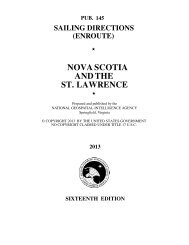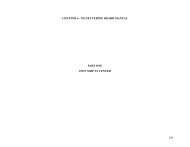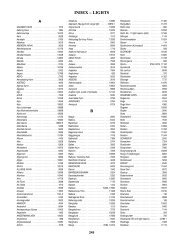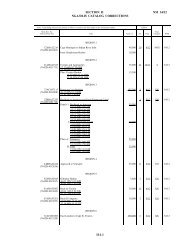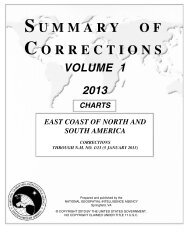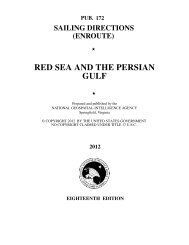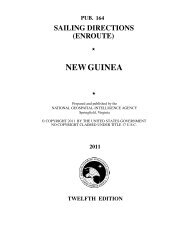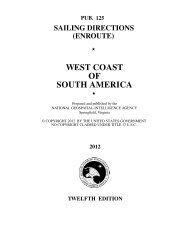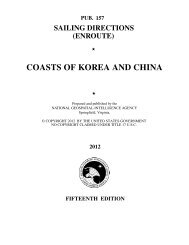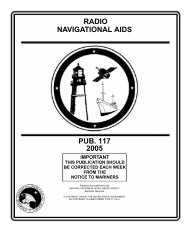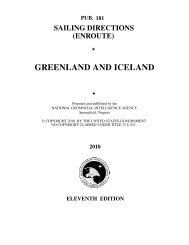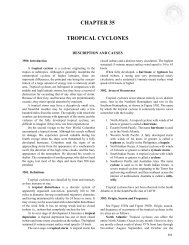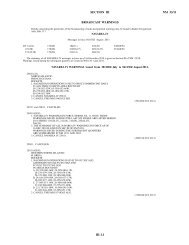LIST OF LIGHTS - Maritime Safety Information - National Geospatial ...
LIST OF LIGHTS - Maritime Safety Information - National Geospatial ...
LIST OF LIGHTS - Maritime Safety Information - National Geospatial ...
You also want an ePaper? Increase the reach of your titles
YUMPU automatically turns print PDFs into web optimized ePapers that Google loves.
The function of a fog signal in the system of aids to navigation<br />
is to warn of danger and to provide the mariner<br />
with an audible means of approximating his position relative<br />
to the fog signal when the station, or any visual signal<br />
which it displays, is obscured from view by atmospheric<br />
conditions.<br />
Fog signals depend upon the transmission of sound<br />
through air. As aids to navigation, they have certain inherent<br />
defects that should be considered. Sound travels<br />
through the air in a variable and frequently unpredictable<br />
manner.<br />
It has been established that:<br />
fog signals are heard at greatly varying distances and<br />
that the distance at which a fog signal can be heard may<br />
vary with the bearing of the signal and may be different on<br />
different occasions;<br />
under certain conditions of atmosphere, when a fog signal<br />
has a combination of high and low tones, it is not<br />
unusual for one of the tones to be inaudible. In the case of<br />
sirens, which produce a varying tone, portions of the blast<br />
may not be heard;<br />
there are occasionally areas close to the signal in which<br />
it is wholly inaudible. This is particularly true when the<br />
fog signal is screened by intervening land or other obstructions;<br />
fog may exist a short distance from a station and not be<br />
observable from it, so that the signal may not be in operation;<br />
even though a fog signal may not be heard from the<br />
deck or bridge of a ship when the engines are in motion, it<br />
may be heard when the ship is stopped, or from a quiet<br />
position. Sometimes it may be heard from aloft though not<br />
on deck;<br />
the intensity of the sound emitted by a fog signal may be<br />
greater at a distance than in immediate proximity.<br />
All these considerations point to the necessity for the<br />
utmost caution when navigating near land in fog. Particular<br />
attention should be given to placing lookouts in positions<br />
in which the noises in the ship are least likely to<br />
interfere with hearing a fog signal. Fog signals are valuable<br />
as warnings, but the mariner should not place implicit<br />
reliance upon them in navigating his vessel. They should<br />
be considered solely as warning devices.<br />
Among the devices in common use as fog signals are:<br />
Radiobeacons which broadcast simple dot-and-dash<br />
combinations by means of a transmitter emitting modulated<br />
continuous waves;<br />
Diaphones which produce sound by means of a slotted<br />
reciprocating piston actuated by compressed air. Blasts<br />
FOG SIGNALS<br />
XVI<br />
may consist of two tones of different pitch, in which case<br />
the first part of the blast is high and the last of a low pitch.<br />
These alternate pitch signals are called “two-tone;”<br />
Diaphragm horns which produce sound by means of a<br />
diaphragm vibrated by compressed air, steam, or electricity.<br />
Duplex or triplex horn units of differing pitch produce<br />
a chime signal;<br />
Nautophones, electrically operated instruments, each<br />
comprising a vibrating diaphragm, fitted with a horn,<br />
which emits a high note similar in power and tone to that<br />
of the reed;<br />
Reed horns which produce sound by means of a steel<br />
reed vibrator by compressed air;<br />
Sirens which produce sound by means of either a disk or<br />
a cup-shaped rotor actuated by compressed air or electricity;<br />
Whistles which produce sound by compressed air emitted<br />
through a circumferential slot into a cylindrical bell<br />
chamber;<br />
Bells which are sounded by means of a hammer actuated<br />
by hand, wave motion, by a descending weight, compressed<br />
gas, or electricity;<br />
Guns and explosive signals which are produced by firing<br />
of explosive charges, the former being discharged<br />
from a gun, and the latter being exploded in midair;<br />
Fog Detector Lights—certain light stations, in addition<br />
to the main light, are equipped with fog detector lights for<br />
automatic detection of fog. These lights sweep back and<br />
forth through an area over which the fog watch is necessary,<br />
showing a powerful bluish-white flash of about 1<br />
second in duration. The interval between successive<br />
flashes will vary with the position of the vessel within the<br />
sector. At the limits of the sector the duration of the flash<br />
may be considerably longer than 1 second.<br />
Fog detector lights operate continuously.<br />
Standby fog signals are sounded at some of the light and<br />
fog signal stations when the main fog signal is inoperative.<br />
Some of these standby fog signals are of a different type<br />
and characteristic than the main fog signal.<br />
Radiobeacons, RACONs, RAMARKs, and radio direction-finders<br />
are mentioned in the List of Lights, but for<br />
detailed information, including the synchronization of<br />
radio signals and sound signals for distance finding, the<br />
navigator should consult Pub. 117, Radio Navigational<br />
Aids.<br />
Note—use Chart No. 1 for the complete list of symbols<br />
and abbreviations commonly used in presenting the<br />
essential characteristics of lights, fog signals, and radio<br />
aids found on charts.



